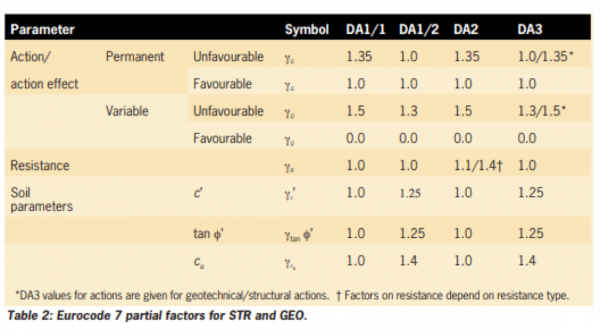Why is modern foundation design conservative?
Geotechnical • Industry matters • Regulation
Eurocode 7 lays down parameters for the design of geotechnical structures. These designs are categorized as ‘Moderately Conservative’. This conservatism is not always ideal, popular or applicable to every site… So what can be done about it?
Before we continue, we get that some may find this guide overly technical. But it is worth persevering as understanding why you cannot do something can help you to understand the art of the possible and for developers our solution is simple.
In this blog we will outline what partial factors are and how they are used. In other words, Geotechnical Design by Calculation and this is a very important part of determining a design bearing capacity, angle of friction or similar. And this all links to why Eurocode 7 design is ‘Moderately Conservative’ and how to get around this.
What are geotechnical structures? And other jargon busted
Geotechnical engineering is the systematic application of techniques which allows construction on, in, or with geomaterials, I.e., soil and rock. Typical geotechnical structures include retaining walls, shallow foundations, piles and slopes.
When designing a geotechnical structure, the engineer needs to identify the possible ultimate and serviceability limit states that are likely to affect the structure. Ultimate limit states are those that will lead to failure of the ground or the structure; serviceability limit states are those that result in unacceptable levels of deformation, vibration, noise, or flow of water or contaminants (for example).
Partial factors have emerged within limit state methodology as a means of adjusting parameters so that appropriate values are derived for design calculations. They safeguard against predictable deformation by factoring down peak soil strength.
Eurocode 7 identifies five ultimate limit states for which different sets of partial factors are provided: failure or excessive deformation in the ground (GEO) and internal failure or excessive deformation of the structure (STR). Loss of static equilibrium (EQU), loss of equilibrium or excessive deformation due to uplift (UPL), and hydraulic heave, piping, and erosion (HYD).
The following ultimate limit states are checked for all geotechnical structures: loss of overall stability (of the ground and/ or associated structures); combined failure in the ground and structure; and structural failure due to excessive ground movement.
Characteristic values – Geotechnical design by calculation involves the geotechnical engineer providing something called a characteristic value. A characteristic value of a geotechnical parameter (soil properties) is a cautious estimate of the value affecting the occurrence of the limit state. In other words, a cautious estimate which avoids catastrophic failure. Cautious meaning ‘WORSE THAN PROBABLE’. (At Ground & Water we believe we should be designing for most probable.)
And this caution is what is behind the conservatism in the Eurocode 7 design parameters.
Design Approaches
The selection of characteristic values for geotechnical parameters takes into account of the following:
- The type and number of samples recovered from the site investigation
- The extent of the zone of ground governing the behaviour of the geotechnical structure at the limit state being considered
- The ability of the geotechnical structure to transfer loads from weak to strong zones in the ground.
There are three design approaches to control the strength of soil and applied load (surcharge). Below are the descriptions.
Design Approach 1 (DA1) – The UK’s Officially Adopted Approach.
There are two combinations from Design Approach 1.
- Combination 1: A1 + M1 + R1
- Combination 2: A2 + M2 + R1
Design Approach 2 (DA2)
Combination: A1 + M1 + R2
Design Approach 3 (DA3)
Combination: (A1 or A2) + M2 + R3

In the UK, assessment of the Eurocode 7 Ultimate Limit State (ULS) must be carried out using Design Approach 1.
In most cases this involves two design checks:
- Primarily involves an ‘action factor’ approach (Design Approach 1, Combination 1, termed DA1/1).
- Primarily involves a ‘material factor’ approach (Design Approach 1, Combination 2, termed DA1/2).
A review of the current literature on Eurocode 7 indicates differences of opinion on how best to undertake DA1/1 checks (the same differences of opinion also apply to the “action/resistance factor” Design Approach 2, DA2, checks). This can lead to inconsistent application of Eurocode 7 when undertaking a numerical analysis, which in turn can lead to differences in the resulting design solutions.
However, the aim has always been to provide a system where a balance between unfavourable (or destabilising) and favourable (or stabilising) forces is provided in a ‘worse than probably’ manner.
So how do you avoid ‘Moderately Conservative’?
Well, Eurocode 7 does give you the answer and the answer was given in a previous G&W Guide to… on this blog.
It’s all about the Quality of Site Investigation & Serviceability
But in summary, the characteristic values we will end up using in the Eurocode 7 design calculations, will be solely dependent on how good the data is we have been able to gather from your site. The key point is if we are able to conduct a high quality site investigation and undertake comprehensive testing and recover Class A samples, we will start with the bar set much higher before the partial factors and characteristic values are applied. These then become less of a worry allowing a less conservative design, which ultimately will save you money in terms of construction costs. As we indicated earlier… A simple solution for developers to a complex and potentially expensive challenge.
